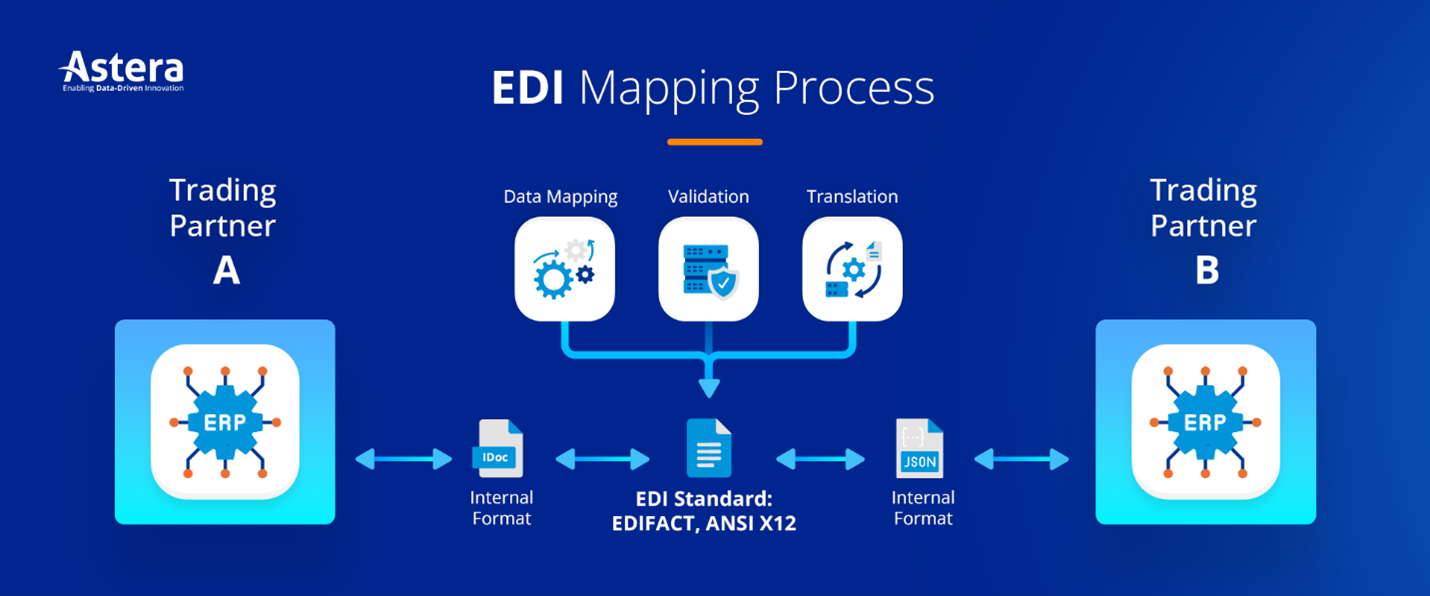
EDI Mapping and Translation: Key to Seamless Integration
In the intricate web of modern business networks, interconnections lie between organizations, suppliers, and customers. Navigating this complexity is essential for sustainable business growth and profitability. The digital era has ushered in a massive heap of data, presenting businesses with the opportunity to exchange information with their partners and stakeholders more effectively.
According to an IDC study, the volume of digital data generated worldwide is projected to reach a staggering 175 zettabytes by 2025. Within this data deluge, businesses often grapple with diverse data formats, disparate systems, and complex integration requirements.
Fortunately, Electronic Data Interchange (EDI) mapping has emerged as a powerful approach that untangles the knots of complex data exchanges. By aligning data elements and formats, EDI mapping brings clarity, efficiency, and simplicity to business networks, streamlining operations and fostering seamless communication.
Understanding EDI Mapping
EDI mapping refers to the process of matching the data structure and format of two systems that are exchanging EDI documents. This process ensures that the receiving system correctly interprets the data sent by the other system. The mapping process requires one system to act as the source and another as the target.
For successful mapping, the structure and format of both systems must be compatible and well-defined. The objective is to ensure compatibility and accurate interpretation of data when exchanging information between trading partners who may be using different EDI standards or versions.
For example, consider a company whose ERP system generates purchase orders in one EDI format (X12), while its supplier uses a different EDI system (EDIFACT). The company must perform EDI mapping to align the data elements (e.g., buyer, seller, item codes) between the two standards.
This mapping process ensures accurate interpretation and understanding of the purchase order data by the supplier’s system, enabling smooth business transactions.
The Role of EDI Translation in Integration
EDI translation, on the other hand, involves the conversion of data from proprietary and non-standard formats used within an organization (such as XMLs, PDFs, and emails) into structured and standardized formats that comply with EDI standards. The purpose of this EDI translation is to enable effortless integration and automated processing of these business documents within the EDI ecosystem.
For instance, if a supplier receives a purchase order from a customer in a PDF format, EDI translation can be used to convert the purchase order into a corresponding standardized EDI format, such as an ANSI X12 850 document. This conversion ensures that the purchase order follows the structure, syntax, and rules defined by the EDI standard, allowing for efficient processing and integration into the supplier’s system.

The Importance of EDI Mapping and Translation in Business Processes
EDI mapping brings numerous advantages that enhance business processes and operations. Here are some key benefits:
- Accuracy and Consistency: Mapping data elements and enforcing data standards ensure consistent and precise interpretation of information. Organizations can use EDI mapping to align data fields such as product codes, quantities, pricing, and shipping details, all while ensuring data integrity throughout the transaction lifecycle. Compared to the manual data entry process, EDI significantly reduces the chances of errors and discrepancies, paving the way for more accurate and reliable data processing.
- Streamlined Workflows: EDI mapping automates data transformation and validation, streamlining business workflows. Configured mapping rules facilitate the automatic processing of incoming EDI documents, which eliminates the need for manual intervention. This automation accelerates order processing, invoicing, and other critical operations, leading to faster order fulfillment and improved customer responsiveness.
- Improved Connectivity: EDI mapping simplifies business communications by enabling the use of standardized data formats like flat-file formats for smooth data exchange throughout supply chains. This eliminates the need for partners to have identical systems or technologies, therefore allowing for successful integrations with those who may not be familiar with or equipped for EDI. This enhanced connectivity streamlines business interactions, facilitating efficient collaboration with partners of varying EDI capabilities.
- Enhanced Partner Collaboration: Effective EDI mapping promotes seamless collaboration with trading partners. By aligning data formats, organizations can easily exchange EDI documents with partners, regardless of the systems or formats they use. This streamlined communication fosters strong relationships, improves supply chain visibility, and enables efficient inventory management and replenishment. Considering that only 21% of industry professionals have achieved supply chain visibility, it becomes increasingly crucial for businesses to leverage EDI mapping if they want to gain a competitive edge.

EDI Mapping Approaches
To optimize EDI implementation, businesses must understand two key mapping approaches: direct EDI mapping and indirect EDI mapping. These two approaches offer distinct advantages in addressing diverse data translation needs, allowing businesses to thrive in the ever-changing digital landscape of modern business transactions.
Direct EDI Mapping
Direct EDI mapping refers to the process of directly translating data between two different EDI formats or standards. It employs a 1:1 mapping approach, where each data element from the source EDI document is precisely mapped to its corresponding element in the target EDI document. This mapping process ensures an accurate data conversion between the two formats without an intermediary representation. For example, X12 purchase orders can be converted to the UN/EDIFACT format.
This approach is suitable when the source and target formats have a well-defined mapping relationship. It works best when there is a clear and straightforward correspondence between the elements of the two formats. This approach eliminates the need for additional transformations or intermediate representations, streamlining the data conversion process.
Indirect EDI Mapping
Indirect or canonical EDI mapping involves using an intermediate or canonical master format (CMF) to map data between different EDI formats. Instead of creating a direct mapping between the source and target formats, the data is first mapped to a common, standardized format and is then subsequently transformed into the desired target format. An example of indirect EDI mapping would be mapping X12 and UN/EDIFACT purchase orders to a canonical XML format before converting them to a custom XML format for internal systems.
Indirect EDI mapping is useful when complex mapping relationships exist between different formats or additional transformations are needed before reaching the desired target format. It allows for flexibility in handling diverse EDI layouts by leveraging a common intermediate representation. This approach is more versatile and adaptable for managing EDI data conversions.
Best Practices for Successful EDI Mapping
To achieve the most seamless interoperability capabilities and maximize the benefits of utilizing EDI tools, businesses can adhere to key best practices that ensure efficient mapping processes and optimal data compatibility. Here are some essential best practices to consider:
- Understand the Data Requirements: Data requirements should be understood before mapping. For example, you may require data on elements such as buyer, seller, item code, quantity, and price for purchase orders.
- Use Standardized Data Formats: Widely accepted data formats such as ANSI X12, UN/EDIFACT, or XML should be used. For instance, the X12 810 standard or the EDIFACT INVOIC format can be employed for mapping EDI invoices.
- Maintain a Comprehensive Data Dictionary: A comprehensive data dictionary should be kept, describing and defining all data elements, segments, and codes. This dictionary can be tailored according to individual needs, such as including a description like “PO Number” for the data element “PONUM.”
- Follow Consistent Naming Conventions: Consistent naming conventions should be followed for data elements, segments, and codes. For example, use prefixes like “BEG” for purchase order header segments and “IT1” for item segments.
- Validate and Test the Mapping: Thorough validation and testing of the mapping should be conducted to ensure accurate data interpretation, which will confirm that the mapped data aligns with expected formats and business rules.
- Document the Mapping Process: The mapping process should be documented, capturing mapping rules, transformations, and considerations. For example, specific handling of data exceptions or business-specific mapping requirements should be recorded.
- Maintain Mapping Version Control: Version control should be implemented to maintain mapping versions and track changes. Utilizing version control software can ensure proper management and traceability of different mapping versions.
Astera EDIConnect: Simplify Business Data Exchange
EDI mapping redefines how businesses communicate, collaborate, and exchange information, exceeding the boundaries of traditional methods. By embracing the power of EDI mapping and translation, organizations can future-proof their operations and gain the ability to adapt to changing industry requirements, emerging technologies, and evolving business models. This enables businesses to confidently navigate the digital landscape, fostering growth, efficiency, and competitiveness in an interconnected world.
Astera EDIConnect facilitates easy EDI mapping, making data exchanges within complex business networks effortless. It offers an intuitive user interface with visual tools for building bi-directional integrations, making it easier and faster for anyone to use. With built-in transaction sets, accurate file translation and ingestion become seamless, eliminating manual efforts and ensuring reliable data processing.
Additionally, advanced data mapping and validation capabilities provide greater control over data integration, enhancing data quality. Astera EDIConnect accelerates partner onboarding by simplifying the mapping process and ETL workflows, facilitating seamless data exchange and collaboration with trading partners.
By leveraging these features, organizations can optimize data transfers, improve accuracy, and enhance efficiency. To discover the transformative capabilities of Astera EDIConnect firsthand, schedule a personalized demo today.
 Astera AI Agent Builder - First Look Coming Soon!
Astera AI Agent Builder - First Look Coming Soon!


